If you are looking wholesale lighting solutions, click here.
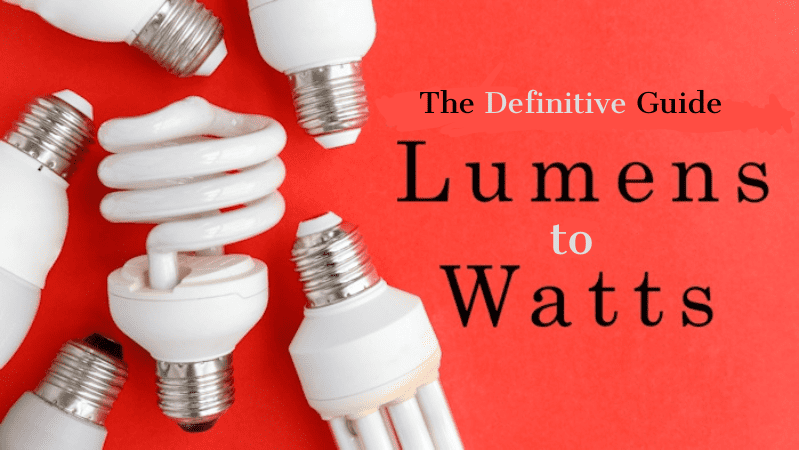
In the ever-evolving world of lighting technology, understanding the relationship between lumens and watts is pivotal. No longer are watts the definitive means of measuring the brightness of a light bulb.
In fact, using watts to determine the illumination capability of a fixture can lead to misleading conclusions and poor lighting design.
This article simplifies lumen-to-watt conversion and discusses the benefits of using lumens in your lighting design.
Lumens (lm) is the unit of luminous flux, a quantitative measure of the light intensity of a light source. More lumens means brighter light bulbs, which lead to a more well-lit space.
While bulb wattage ratings are a decent way to estimate a fixture’s light output, they don’t show the full picture. Lumens are a more accurate way of measuring light brightness levels.
Today, lumen is a more reliable brightness indicator as it describes the objective brightness level of a fixture. Consumers can look at the wattage and lumens of a light fixture and make more informed buying decisions.
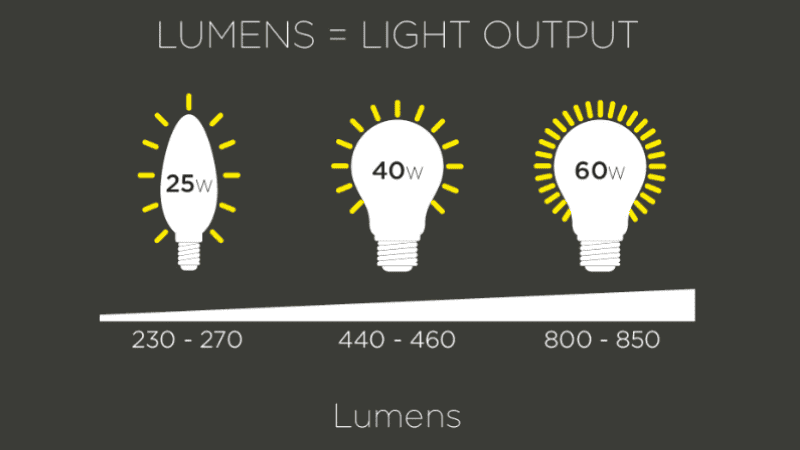
Wattage to brightness level scale changes with the lighting technology. A 100 W incandescent bulb produces ~1000 lumens of light, but the same brightness level can also be achieved with a higher quality 15W LED (light emitting diode) bulb.
With modern energy-efficient lighting options, watts have become a less reliable metric. Hence, manufacturers are now focusing on the lumen output of light bulbs instead of watts.
A foot-candle is a measure of luminance from a light source at a specific distance. One foot-candle means a one-lumen light bulb will light up a one-square-foot surface from a distance of one foot.
Lumen is a constant value and remains the same at any distance. Foot-candle decreases as you go further away from a light source.
Watt (W) is the unit of power and describes the per-second energy output of a device. Higher watts mean more power consumption. Although watts can be used to measure many attributes, it is commonly used for the electric power consumption of a device.
A high-wattage bulb means it consumes a lot of electric power from the grid. Watts is not a direct indication of bulb luminance or brightness capabilities.
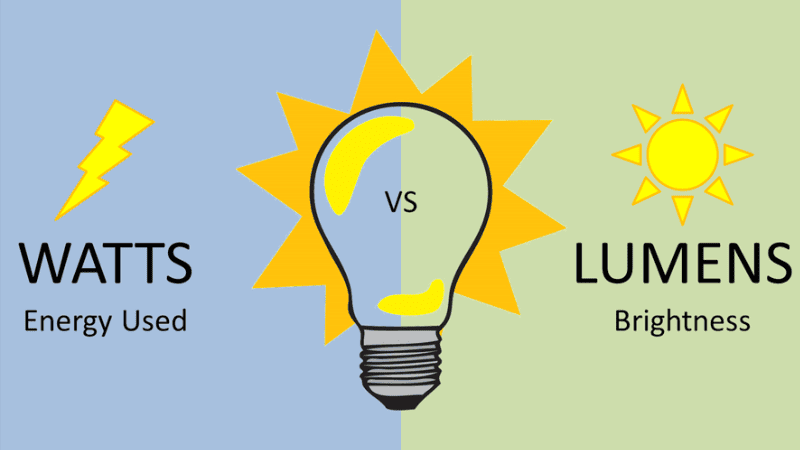
For example, a 25 W incandescent bulb will output approximately 250 lm of brightness, but only 3 W of electricity is being converted to light. The remaining 22W ends up as heat. Energy efficiency refers to the ability of a light bulb to convert the watts to lumens.
Lumens to watts conversion is an important factor for anyone looking to optimize the energy-saving aspect of their business or home.
Lighting up a large workspace requires a lot of planning and prep work. If you have an estimated lumen target for your place, you can calculate the watts requirement for your lighting design.
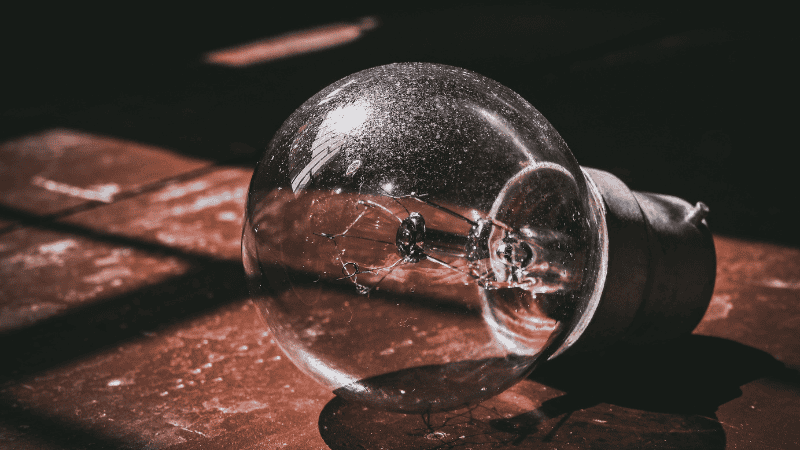
Lumens to Watts conversion and vice versa is a simple formula that requires at least two known values.
In today’s energy-efficient world, calculating watts before you make a purchase is a great way to ensure you’re getting the best bang for your buck.
All lighting product packaging lists the power consumption in watts, and a general lumen per watt is associated with different lighting technologies. Multiplying these two metrics, you can easily calculate the lumens of light bulbs.
Lumens (lm) = Watts (W) x Luminous Efficacy (lm/W)
Now, simply reverse engineer the lumens formula to get your watts conversion.
Watts (W) = Lumens (lm) / Luminous Efficacy (lm/W)
The estimated wattage calculated from lumens varies heavily from one lighting technology to another. Older incandescent bulbs are way less efficient than modern LED ones and thus have a lower lumen per watt value.
| Lumens to Watts | |||||
| Lighting Technology | Incandescent | Halogen | HID | CFL | LED |
| 250 Lumens | 25W | 18W | 15W | 6W | 3-4W |
| 450 Lumens | 40W | 28W | 25W | 10W | 5W |
| 750 Lumens | 60W | 42W | 40W | 12W | 6W |
| 1200 Lumens | 75W | 55W | 50W | 25W | 12W |
| 1600 Lumens | 100W | 80W | 72W | 30W | 22W |
| 2600 Lumens | 150W | 140W | 100W | 35W | 27W |
The above-shown watt conversion chart shows that older lighting technologies require more than ten times the electrical energy to meet a desired lumens count. Halogens and incandescent bulbs are highly inefficient and waste a lot of power as heat.
While CFL light bulbs are pretty impressive, especially for their lower costs, they still break easily due to their glass construction and use of toxic substances in their production.
LED bulbs win the efficiency race by a country mile. Doing so while consuming less energy and being more durable.
Luminous efficacy measures a light source’s ability to convert electrical energy into visible light energy. It is commonly known as lumens per watt (lm/W).
A high luminous efficacy means the product is highly energy efficient and will deliver excellent illumination to a space without consuming a lot of power.
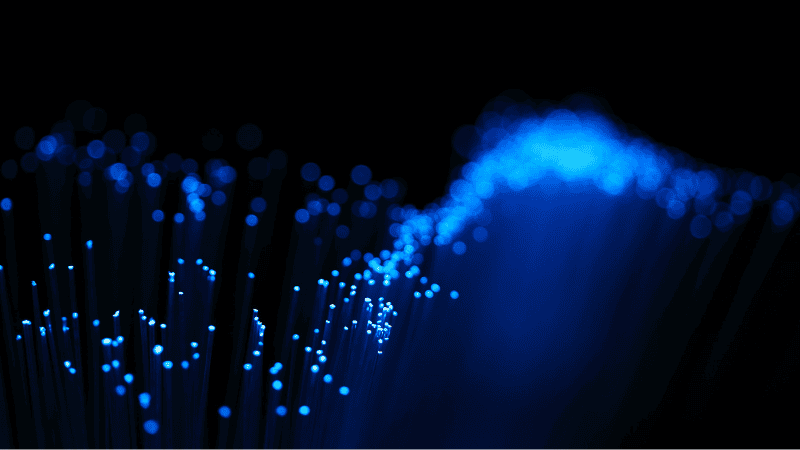
Buyers looking to reduce their carbon footprint or simply save on their electricity bill should always consider the luminous efficacy of light bulbs.
Luminous efficacy is simple to measure if you know a given light bulb’s wattage and lumen output. Most manufacturers list both values on the product packaging or their website.
For large industrial projects, the supplier will send you a product specifications list with all the necessary details.
We can use the same lumens-to-watts conversion formula for luminous efficacy.
Luminous Efficacy (lm/W) = Lumens (lm) / Watts (W)
Although highly unlikely, if by chance you are unable to confirm the lumens or watts of a given light source. You can use off-the-shelf measuring tools.
The luminous efficacy of a given light bulb is determined by its means of illumination.
| Light Technology | Standard Luminous Efficacy (lm/W) |
| Incandescents | 12-18 |
| Halogens | 10-20 |
| CFL | 50-70 |
| LED | 80-100 |
| Metal Halide Lamp | 75-100 |
| Low Pressure Sodium Vapor Lamp | 100-180 |
| High Pressure Sodium Vapor Lamp | 60-120 |
| Mercury Vapor Lamps | 30-40 |
The light output of any light bulb is a result of various factors. Some factors affect their luminance, while others lead to better color rendering.
Following is a short list of factors that affect the luminous efficacy of a light source.
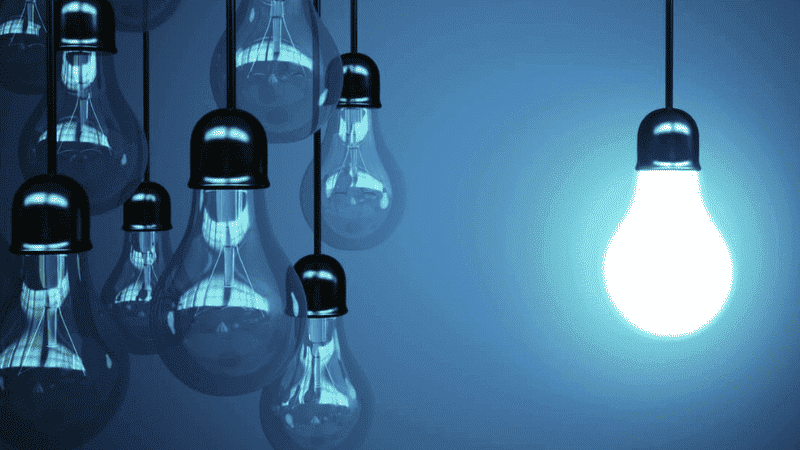
We have already discussed the role lighting technology plays in the lumens-to-watts ratio. Incandescent, halogen, CFL, etc., are less energy efficient.
Metal halide, sodium vapor, and mercury vapor lamps have exceptional luminous efficacy. Last but not least, LED technology is a good balance of energy efficiency, availability, and convenience.
Color temperature is the hue of light measured in Kelvins. A high color temperature means the light has a bluish tone, and a low color temperature means it has a yellowish tone.
Manufacturers often limit the bulb’s maximum brightness or add different additives to a light bulb to control its color temperature. Resulting in a slightly lower luminous efficacy.
Luminous efficacy scales non-linearly with wattage, meaning doubling a light bulb’s wattage doesn’t double the lumens count. In fact, the lumens to watts conversion becomes more energy efficient at higher energy consumption.
For example, a 3W LED bulb can generate around 200 lumens. However, generating 2000 lumens only requires 20W. So, with seven times more power, LED bulbs can produce ten times more illumination.
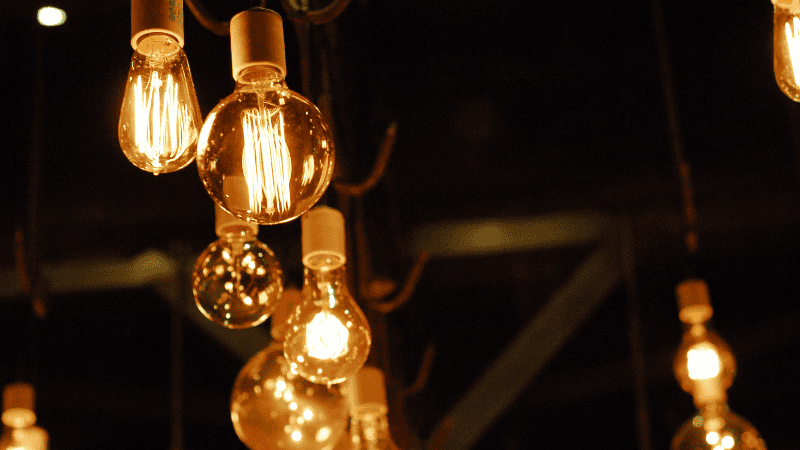
Light bulbs are designed to operate under specific temperatures. Going outside this range will degrade their efficiency and reduce the total amount of light emitted from the fixture.
Material degradation over time is a real threat to all lighting systems. Aging causes traditional incandescent bulbs to burn out and die.
But with LED technology, the bulbs lose their luminance (brightness) over time instead of burning. Reducing their luminous efficacy towards the end of their life cycle.
Now that you have a good understanding of lumens, watts, and their direct relationship with one another, let’s move on to real-world examples and the recommended lumens for a given area.
| Example Space | Recommended Foot-Candle | Recommended Lumens |
| Hallway | 5-10 fc | 500-1,000 lm |
| Bedroom | 10-20 fc | 1,000-2,000 lm |
| Living Room | 10-20 fc | 1,000-2,000 lm |
| Dining Area | 30-40 fc | 3,000-4,000 lm |
| Restaurant | 50-60 fc | 5,000-6,000 lm |
| Home Office | 50-75 fc | 5,000-7,500 lm |
| Bathroom | 70-80 fc | 7,000-8,000 lm |
| Kitchen Ambient | 30-40 fc | 3,000-4,000 lm |
| Kitchen Stove | 70-80 fc | 7,000-8,000 lm |
| Industrial Workspace | 80-100 fc | 8,000-10,000 lm |
| Classroom | 40-100 fc | 4,000-10,000 lm |
| Library | 60-100 fc | 6,000-10,000 lm |
Although a lumen count is more than enough to help you make informed buying decisions, foot-candle recommendations can help you further refine your lighting design.
You can multiply the recommended foot-candle with your workspace area (sq. ft.) to get more accurate lumen values.
Good lighting is all about choosing the right fixture for a given space. Consider your lighting requirements, budget, and convenience before selecting bulbs for your home, business, or factory.
Follow five quick steps and get the perfect lighting bulb, lamp, or strip for your space.
The first step in choosing the right light source is to pen down your lighting requirements. Think about your application and evaluate your brightness requirements. You can use the charts shown above to get a general idea.
Task lighting requires more lumens than ambient lighting. Hence, spaces like kitchens, offices, factory floors, and alike need more lumens. Other less critical spaces, like restaurants, bedrooms, and outdoor sitting areas, can get away with lower lumen values.

Additionally, open spaces should account for natural light. How many lumens a space needs in the daytime, and how many lumens does it need at night? This is an important deciding factor that will directly impact your lighting design.
Read the product description printed on the box to see if it meets your lighting needs. Be on the lookout for the following specifications.
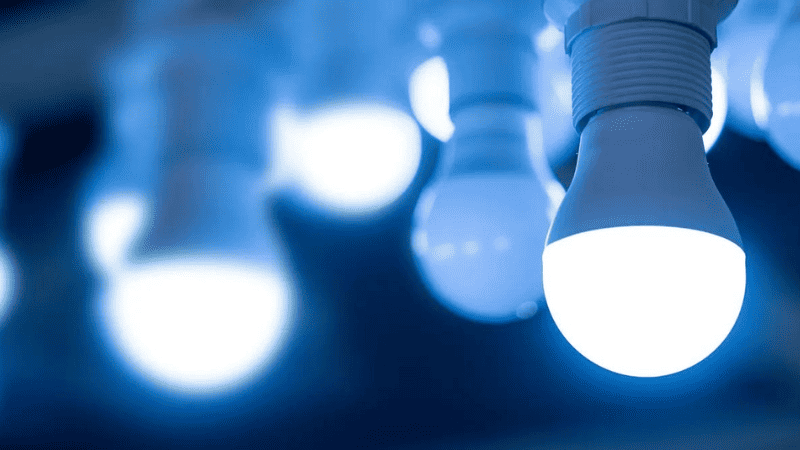
Color temperature correlated color temperature (CCT) can help you manage the atmosphere and ambiance of a space. We can divide it into three ranges for the most common applications.
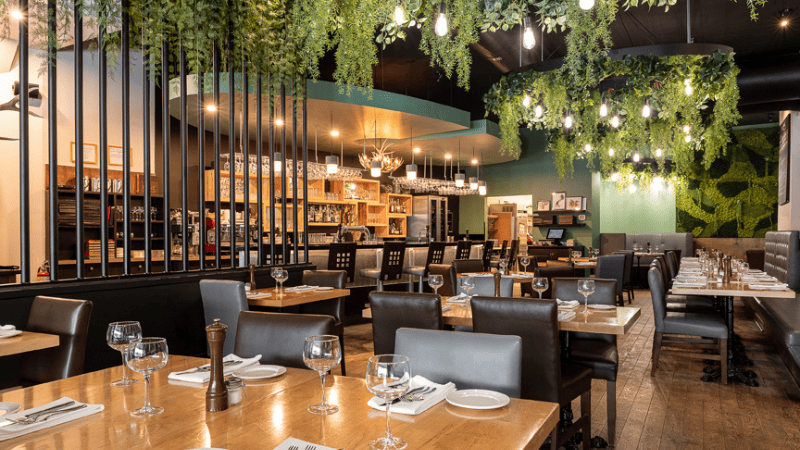
The color rendering index is a quantity measure of an artificial light source’s ability to mimic natural sunlight. It has a range of 0-100 with a maximum of 100 CRI, meaning the light source has the same light quality as sunlight.
Consultations are always a helpful tool for any lighting design project. Smaller lighting projects are forgiving, and small mistakes have minimal impact on the final lighting setup.
However, larger commercial lighting projects can quickly go sideways at the smallest of mistakes. Most lighting manufacturers and suppliers have lighting experts on staff who can guide you and help refine your lighting design.
LED technology has been growing rapidly and slowly taking over all lighting fields. LED bulbs offer a long list of benefits to consumers in the residential and commercial sectors.
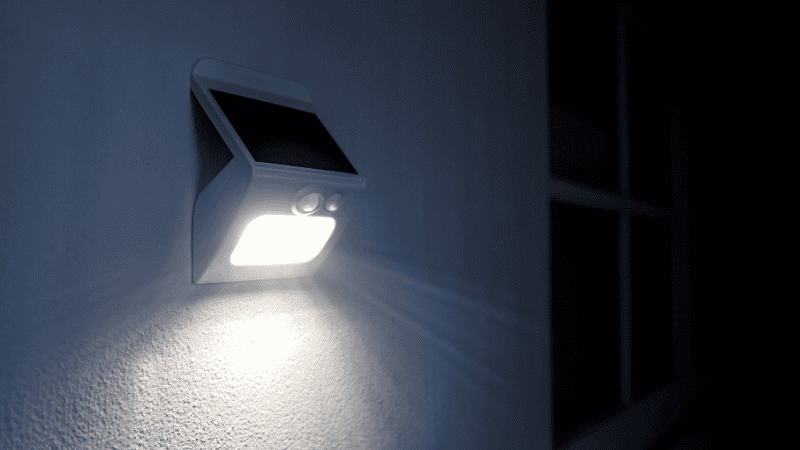
One of the most compelling reasons to choose LED lights is their remarkable energy efficiency. These tiny semiconductors are masters of converting electricity into light, significantly outshining traditional lighting technologies.
LEDs can produce more light while consuming fewer watts than incandescent or fluorescent lights. As the demand for energy grows so do the energy costs, resulting in higher electricity bills that many can’t afford.
A switch to LEDs will help decrease the total energy consumption of an area (city or country) which will have a positive result on our society.
Lower energy consumption also means less heat output from the fixture. Meaning you will end up spending less on air conditioning.
When assessing a light source’s brightness, it’s vital to consider its luminance efficacy or lumen-to-watt ratio. LEDs excel in this department, providing more lumens for the same or even less wattage compared to traditional bulbs and matching specialized HID lamps.
For example, a 10-watt LED bulb can offer the same or even greater brightness as a 60-watt incandescent bulb. Resulting in less power consumption, higher brightness, and more cost savings.
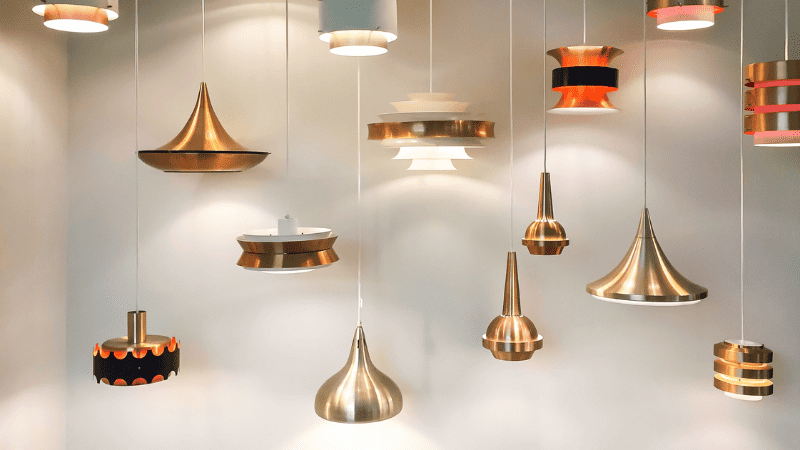
LED fixtures last a very long time. Their polycarbonate shell keeps them safe from impact damage, lower energy consumption prevents overheating, and high-quality parts prevent burnout.
Their operational lifespan, on average, ranges from 25,000 to 50,000 hours, with higher-quality parts lasting much longer.
LED’s exceptional longevity translates into fewer replacements, reduced maintenance costs, and minimal disruption in homes, offices, or industrial settings.
When you install LEDs, you can enjoy reliable lighting for years, making them a sensible choice for areas where continuous illumination is essential.
LEDs are inherently robust and durable, built to withstand harsh conditions, vibrations, and extreme temperature changes. Unlike fragile incandescent bulbs, that can shatter with the slightest impact, LEDs can handle the rough and tumble of various environments.
This durability is particularly valuable in settings where reliability is critical, such as automotive work, industrial applications, and outdoor lighting.
Additional LEDs enjoy durability in the form of water and dustproofing. LEDs with high IP ratings are fairly common and affordable.
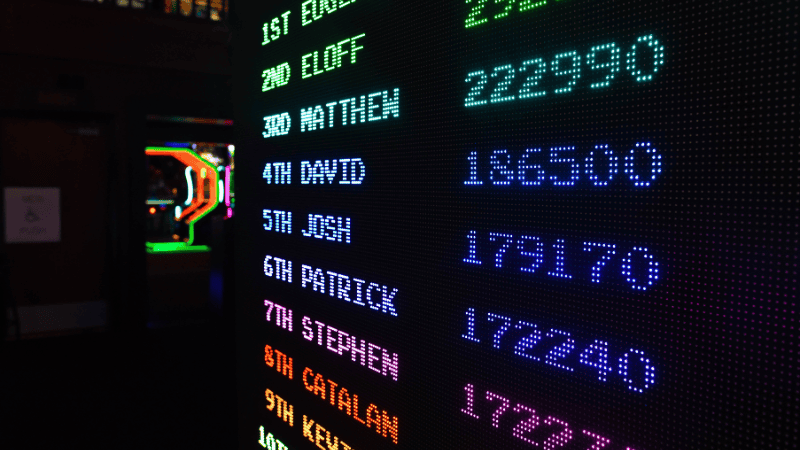
The world of LED lighting offers a vibrant palette of colors to choose from, giving you the freedom to fine-tune your lighting design. LEDs can produce a wide spectrum of colors, from warm yellow to neutral white to cool blue.
But color temperature isn’t the only means of customizing your lighting design. Addressable RGB LEDs can produce over 16 million colors using a combination of red, blue, and green diodes.
Further broadening LED lighting’s applications and making it particularly useful for accent and mood lighting.
A versatile color selection gives LEDs the flexibility to fit into any lighting design such as decorative lighting, architectural lighting, signage, displays, and creating personalized lighting atmospheres.
LEDs are versatile lighting tools that can be deployed in a number of situations. Their compact size and adaptable design make them a perfect fit for any given lighting design.
Whether you’re illuminating a room with recessed downlights, accenting architectural features with spotlights, creating eye-catching signage, or generating a party ambiance with LED strips, LEDs can be seamlessly integrated into various settings.
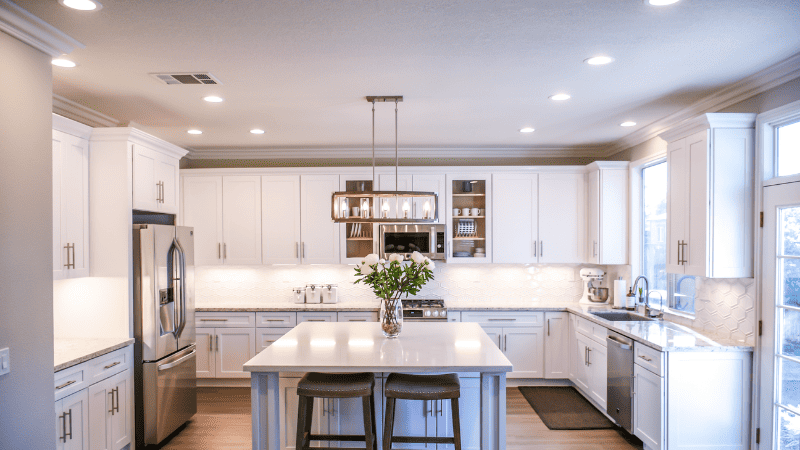
Additionally, LEDs are readily compatible with dimming systems, enabling you to adjust the light level to your liking, conserve energy, and create different lighting moods.
The lighting world is transforming remarkably, driven by technological advancements, environmental concerns, and evolving user preferences.
As we step into the future, here are some of the key trends in lighting technology that aren’t showing signs of slowing down.
Smart lighting systems have become more and more common in the lighting industry. Professional lighting applications use smart control systems like DALI or DMX to automate and remotely adjust LEDs’ brightness, colors, and operational timing.
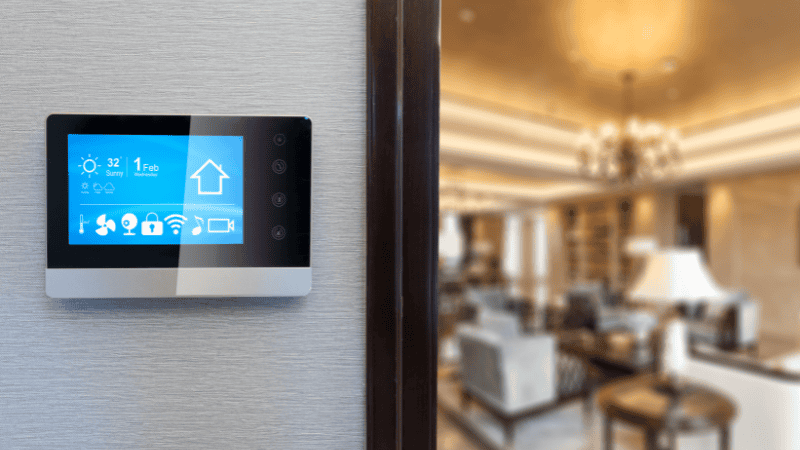
In the domestic setting, we see smartphone apps integrated into a house’s lighting system that can control the lighting remotely using a Wi-Fi connection. Giving a level of control to consumers that has never been seen before.
Additional features like motion sensors in rooms automatically turn off lights when no one is present, leading to lower energy consumption and a lower electricity bill.
Smart lighting is still in its infancy, but will soon become a household staple.
Human-centric lighting (HCL) is the concept of designing artificial lights such that they mimic the look, feel, and pattern of natural daylight. All in an effort to improve people’s lives by enhancing productivity, improving mood, and boosting health.
HCL adjusts light intensity, color temperature, and spectrum to align with our biological clocks, providing the right light at the right time. Artificial blue light can disrupt our circadian rhythm, leading to poor mental and physical health.

With global warming and environmental damage at its peak, the pursuit of sustainability has taken center stage in the evolution of lighting technology.
The future of sustainable lighting can be divided into three steps
Energy efficiency remains a foundational trend in lighting technology. Traditional incandescent bulbs are being phased out in favor of energy-efficient alternatives like compact fluorescent lamps (CFLs) and light-emitting diodes (LEDs).
These technologies offer substantial energy savings, producing the same or better quality of light while consuming significantly less electricity. Using energy-efficient bulbs will also help decrease the burden on renewable power generation systems.
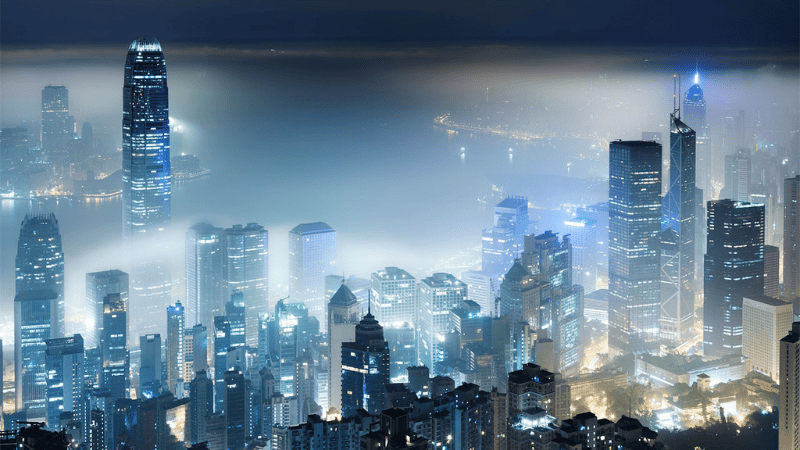
Light pollution is the excessive or misdirected artificial light that brightens the night sky and spreads to our surroundings. It not only obscures our view of the stars but also has ecological, health, and economic implications.
The future of lighting design involves reducing our use of artificial light in favor of natural daylighting and pre-planning outdoor lighting to avoid further light pollution.
The underlying lighting technology determines the number of lumens (lm) in a watt (W) of power. For incandescent bulbs, it’s 10 lm/W, for CFLs, it’s 40 lm/W, and for LEDs, it’s 80 lm/W.
Check the OSHA lighting guidelines for the recommended foot-candle for a given space. Then multiply your workspace area (in square feet) and the foot-candle to get the appropriate number of lumens
A 1000 lumens torch is so bright that it can cover over 200m of ground in front of you. It takes an incandescent bulb roughly 70W to 1000 lumens of light, a CLF can accomplish the same task with just 20W, and an LED bulb can do it in just 10W.
No. In fact, 800 lumens might be too little for task-oriented spaces. For a normal 100 sq. ft. bedroom, 1000 lumens is recommended.
A 100W incandescent bulb produces a little over 1600 lumens of light. An LED light fixture can produce the same amount of light for 15-20W.
The increasing focus on energy efficiency in the lighting sector has made watts obsolete for determining luminance. Today, a 10W LED light can match the brightness of a 100W incandescent.
So, we must shift our conversation from watts to lumens and lumen efficacy. Manufacturers are already using lumens to market their lighting solutions as the metric better represents their product’s capabilities.
While fixture wattage is still an important metric, it should be used in conjunction with lumens for a more accurate estimation.
Risun is all about optimizing supply chain management and delivering the best lighting solutions to global customers in a timely fashion. We offer premium indoor and robust commercial lighting products that are perfect for any application.
Our goal is to boost your business with the best quality products and customer service. See why hundreds of international clients trust us with their lighting needs.
Comprehensive Lighting Solutions for MRO Wholesalers and Professionals
send your inquiry
Hi, I'm the author of this post, and I have been in this field for more than 15 years. If you want to wholesale lighting fixtures or lighting related product, feel free to ask me any questions.
Learn More >>Download our catalog to view all of our lighting products.
Ready to get started ?
Send Your InquiryOur team will get back to you promptly

please
download
Get notified about new products
Our team will get back to you promptly!
Add your first comment to this post